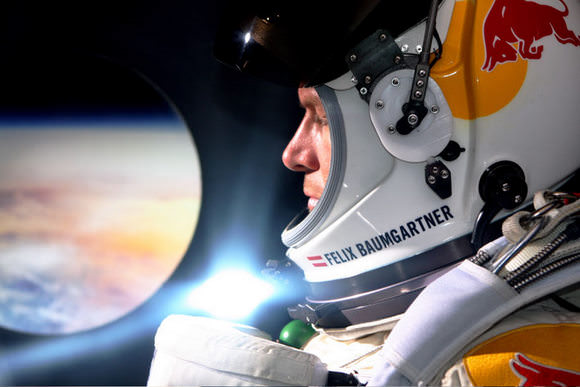[/caption]
Here’s an update on the Red Bull Stratos project, where skydiver Felix Baumgartner will attempt to break the speed of sound during freefall. (Read our preview article). Baumgartner and the project’s aeronautic’s experts recently conducted the latest round of high-altitude test jumps and step-off procedure tests. Baumgartner himself reports feeling both satisfaction and apprehension while the team prepares to move into a new phase of testing.
During the last week in May 2010, the Red Bull Stratos team conducted three important tests. In the capsule step-off test, conducted at Sage Cheshire Aerospace in Lancaster, California, the capsule dangled from a 40,000-ton crane to simulate its suspension from the balloon flight train, with Baumgartner practicing his movements inside, exiting and stepping off. The purpose was to determine how the vessel reacts to Baumgartner’s motion, and whether those reactions could compromise his descent. Even a relatively gentle tumble created by imprecise step-off could not only hinder Baumgartner’s ability to break the sound barrier but also suddenly devolve into a dangerously rapid “flat spin” once he encounters a level of increased air density.

Next, a group of pre-eminent aerospace experts and test pilots – including Joe Kittinger, who holds the records Baumgartner will try to break – gathered in a deserted Palmdale fairground to witness something they’d never seen during all their combined years of experience: a bungee jump in a pressurized space suit and helmet. After multiple jumps from a crane basket suspended 200 feet above the ground, Baumgartner’s exit technique had evolved into something that one team member described as “perfect.”
The finale to the week of testing was a series of skydives over the desert in Perris, California, reaching approximately 26,000 feet. This test, conducted on May 27, 2010, was the first in a fully pressurized suit and was a follow-up to a similar day of flights in early spring. Baumgartner had been frustrated by the awkwardness of his equipment, especially by the way his chest pack – a vital technology hub for the descent – jammed his helmet and inhibited movement on descent and blocked his vision while landing. Objectives were to get a clean step-off from the rear-exit airplane; assess controllability and various body positions in the fully pressurized suit; experience suit deflation upon descent; and test a new chest pack system that allows one side to move out of Baumgartner’s line of sight so he can spot his landing. Baumgartner’s technique and the improved equipment worked so quite well, so the team was able to accomplish all objectives.
Source: Red Bull Stratos


Like the cabin crew says on approach “we’ll be on the ground in 20 minutes” – which is the only thing they can really say with certainty and w/o getting into speculative forward looking statements such as “we’ll be landing in 20 minutes”.
So my prediction: He’ll step off the platform, and some finite time later will hit the ground.
This has tangential value as far as personal EDL is concerned, but generally why is this space news? He’s going in the wrong direction !!!!
And having a possibility of dumping the front pack before landing would be having an added possibility of failure.
This is exciting. I can’t remember which was the folk tale or which was the history, but IIRC when railways started up people where concerned about velocity effects on humans above 30 km/s. (I believe the folk tale was that it was from wind effects, history was that it was from jerking around. … anyway.) Now we are talking free fall bodies from space.
The suborbital and orbital tourist industry will have a winner in this and its spin-offs within a couple of decades.
“And remember, your Bigelow suite is but a Step™ from Earth. You can change your descent package from scheduled capsule to free brake ball and chute any time. (For safety reasons ball release is through the front desk air lock complex. Do _not_ use the suit emergency brake balls for your deorbit.)”
Oops. “30 km/s” was 30 km/h.
Ah TL that just shows where your mind really is, out there among the stars, not hanging around here. 🙂
I wonder if, as the ads say, Redbull will give him wings: http://www.redbullusa.com/cs/Satellite/en_US/athletes-events-entertainment-videos-photos/HolyShit/011242746208542
Spoodle58, where you talking to me? I thought I heard something down there. 😀
@ CEB: But a “splat” is a splat, in either direction…
Joe Kittinger will always be the true pioneer – whether his records are broken or not. No-one even knew whether his rudimentary spacesuit could handle the journey (& one of the gloves did leak). I often show my students video footage of the jump in Physics classes – they are left awestruck.
OK, only problem I would have with this is. . .
That is not a hard suit and he is going to get hurt.
We are talking air flow past Mach one and that does some strange things to surfaces; I would expect to lose a leg or something.
(Oh, and DG I heard the glove came off completely and his hand got about five times bigger than normal. But he got better.)
icecycle, in the shown flight attitude it is his helmet that does the shock transition, the rest of his body will be in a normal subsonic flow regime.
Unless he starts to tumble…
This is really an ambitious project. Traveling faster than the speed of sound is very difficult and dangerous as well. Wishing best of luck to Felix for this…
Force Factor
icecycle, at the bailout altitude the air will be so thin and speed of sound so low that there will be little air resistance and a weak shock wave. Moreover, since the skydiver starts out in still air and gradually gains speed as he falls, it’s much gentler than being launched into the slipstream by an ejection seat out of an aircraft traveling at supersonic speed.
By some accounts, Joe Kittinger exceeded the speed of sound during his Excelsior III jump (August 16, 1960), even while trailing a small drogue parachute. The shock wave was much less of a hazard than a possible pressure suit failure or entering an unrecoverable flat spin, like test dummies did in earlier tests.